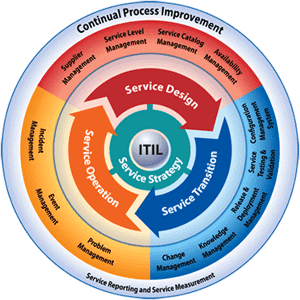ITIL TERMS
Process: a set of coordinated activities combining and implementing
resources and capabilities in order to produce an outcome and
provide value to customers or stakeholders.
Characteristics of every process include:
•They are measurable,
•They deliver specific results
•They deliver outcomes to customers or stakeholders
•They respond to specific events (triggers)
Service: a means of delivering value to customers by facilitating
outcomes customers want to achieve without the ownership of specific
costs or risks.
Owner (Accountable) Manager (Responsible)
RACI MODEL
The RACI model helps show how a process actually does work end to
end across several functional groups by defining roles and
responsibilities, as well as organizational structure.
R – Responsibility (actually does the work for that activity but is
responsible to the function or position that has an “A” against it.) eg
Process manager
A – Accountability (is made accountable for ensuring that the action
takes place, even if they might not do it themselves). eg Process
Owner
C – Consult (advice / guidance / information can be gained from this
function or position prior to the action taking place).
I – Inform (the function or position that is told about the event after it
has happened).
IT Infrastructure: all the hardware, software, networks, facilities,
services and support elements that are required to develop, test,
deliver, monitor, control and support IT Services
Capabilities: The functions and processes utilized to manage
services. Capabilities are intangible assets
"Soft Assets"
Management, Organization, Processes, Knowledge and People
Resources: A generic term that includes IT Infrastructure, people,
money or anything else that might help to deliver an IT service.
Resources are tangible assets
"Hard Assets"
Financial Capital, Infrastructure, Applications, Information and People
Capabilities and Resources = Service Assets
Good Practice: (also referred to as Best Practice) That which is
successful in “wide industry use”
Functions: A team or group of people and the tools they use to carry
out one or more Processes or Activities.
Customer: Any person who authority for requesting a service or who pays for using the service
User: Any employee or staff member that uses an IT service
System: refers to a range of repositories for storing and accessing
information – can include storage and databa
Utility fit for purpose
(What does the service provide)
Warranty fit for use
(level of reassurance and guarantee to meet agreed requirements)
Service Warranty + Service Utility = Service Value |




